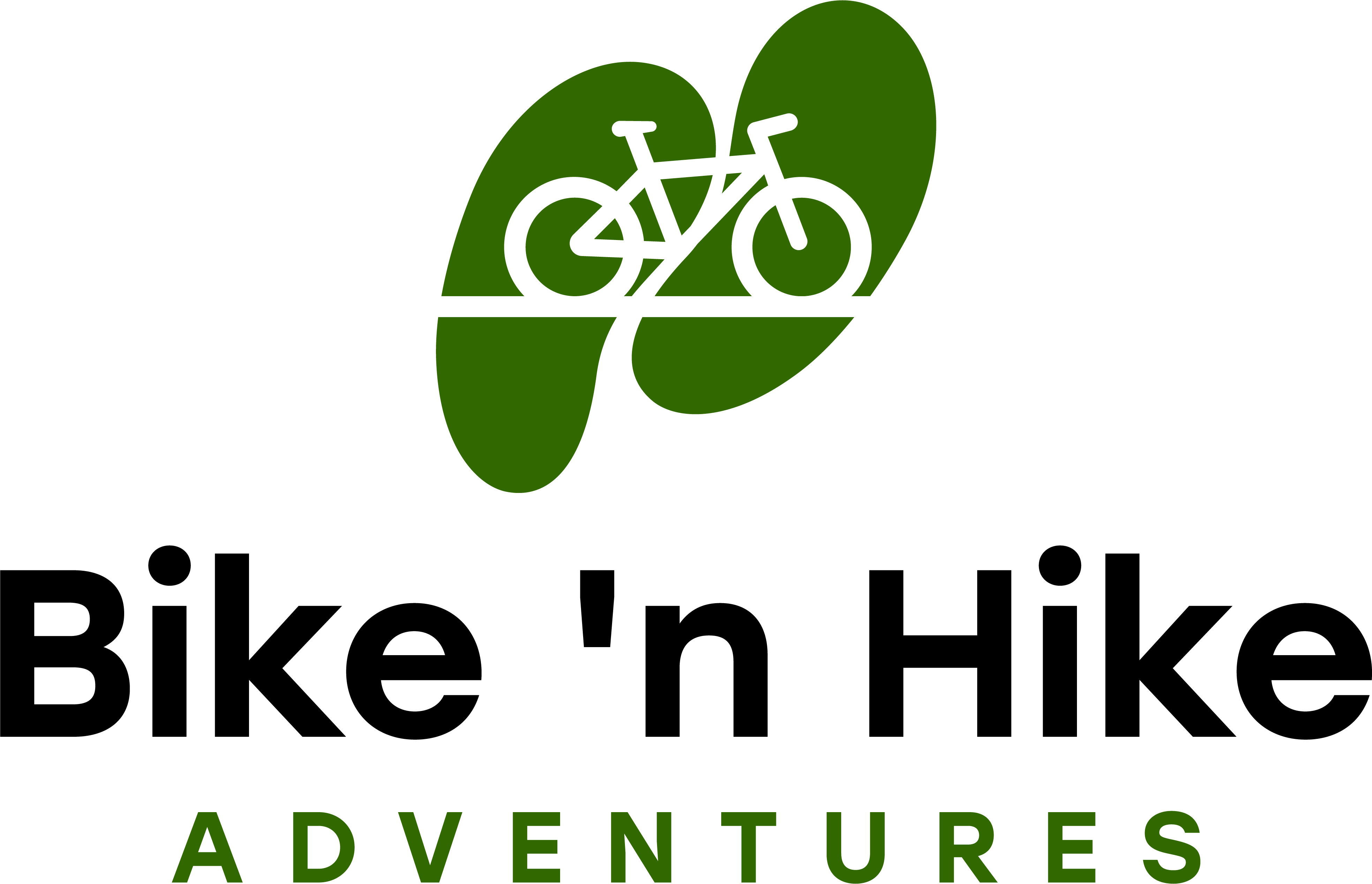Touring Vienna, Bratislava and Budapest
I had the good fortune to be out on a 3-country cycling adventure from Austria to Hungary in May 2024. This trip included 2 days in Slovakia, enabling a wonderful visit to the cities of Vienna, Bratislava, and Budapest.
Vienna
Vienna, the world’s most liveable city for 2024, 23 ad 22 according to the Global Liveability Index. We had about 2 and a half days in Vienna, and of course it wasn’t enough.
We arrived fairly early in the morning, and decided to navigate the local transit system to get to our hotel. It took a while, but we figured it out.
The first excursion for me was to the Albertina Museum, the largest museum for modern art in Central Europe including works from impressionist painters such as Monet and Picasso. My personal favourite kind of art.
The next day many of us visited Schönbrunn Palace, a UNESCO World Heritage Site and one of Austria’s most important cultural assets. Built in 1642, It was once the summer residence of Maria Theresa of the Habsburg dynasty, which ruled Austria for six centuries. It was a massive building with extensive gardens, a large pond with an incredible fountain, as well as a separate dining/viewing building up on the hill.
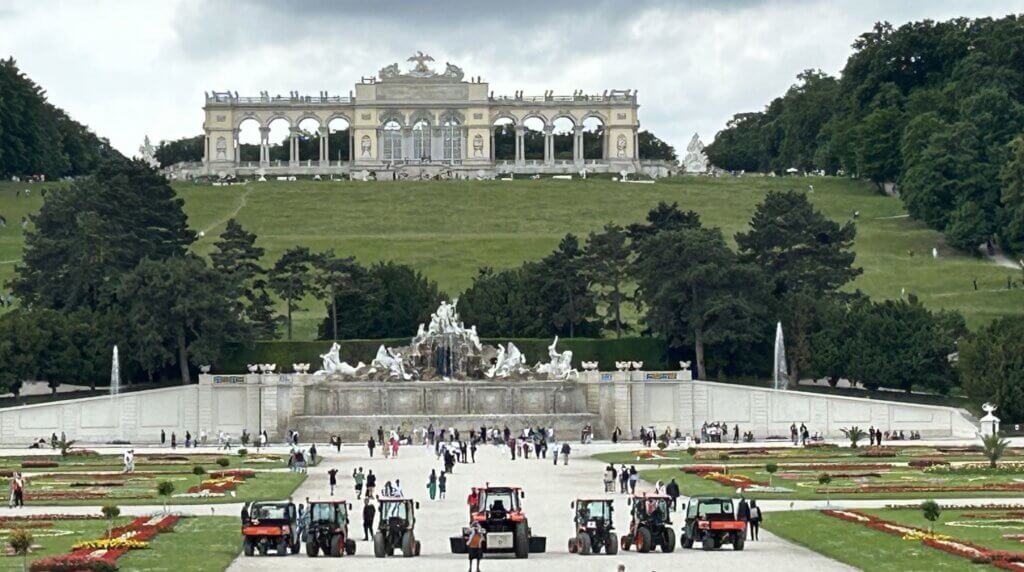
Vienna is a world destination for music so many of us wanted to experience some local music offerings. There are church venues, community venues, and of course the famous Vienna Opera House. So many options, and having only a couple of nights helped with the selection. Some of the group spent a very pleasant evening attending a concert at St. Anne’s Church, which felt very traditional. The next night the Vienna Mozart Orchestra was performing (in period costume) at the Musikverein Golden Hall. This was a fun and interactive concert, with both tourists and locals in the audience.

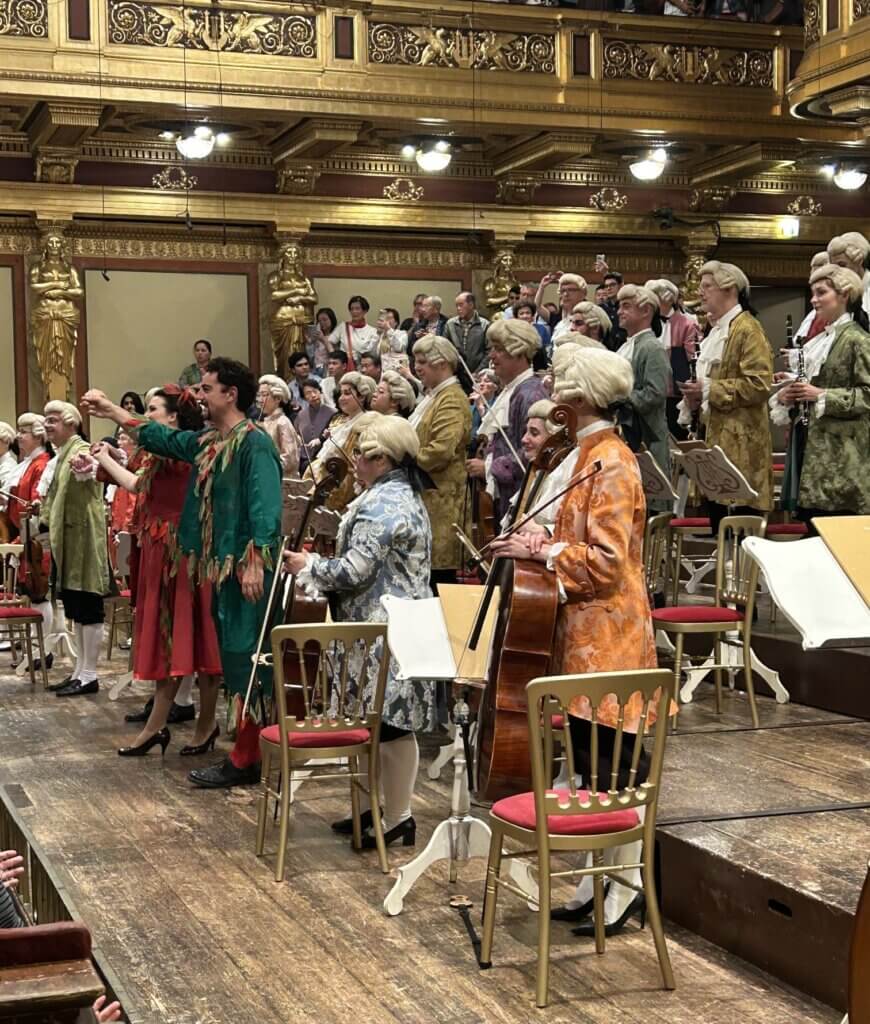
The other wonderful place that we had time for was the Belvedere Museum, home of the world’s largest collection of paintings by Gustav Klimt, Austria’s most famous artist. This amazing collection is housed in yet another large Habsburg palace that became one of the first public museums in the world in 1777.
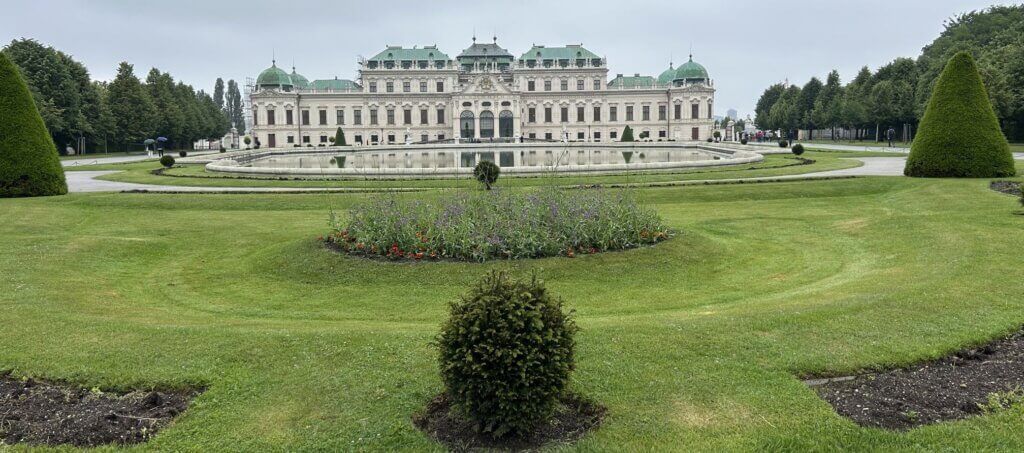
There were so many areas of the city that I didn’t get to, so many museums, so many concert opportunities. All those things wait for a return visit. What we definitely made time for was for Sachertorte, the iconic cake of Vienna.
Bratislava
Our cycling took us to Bratislava, the capital of Slovakia. Bratislava is a delightful city, blending charming old town vibes (replete with cobblestone streets and medieval buildings) with uber modern structures such as the UFO bridge which spans the Danube River. When completed in 1972, this bridge was considered a significant engineering achievement.
There are so many interesting things to see in Bratislava, including the many public statues, the stunning Art Nouveau-style blue Church of St. Elizabeth, the Bratislava Castle, and St. Martin’s Cathedral, where Hungarian kings and queens were crowned for almost 300 years.
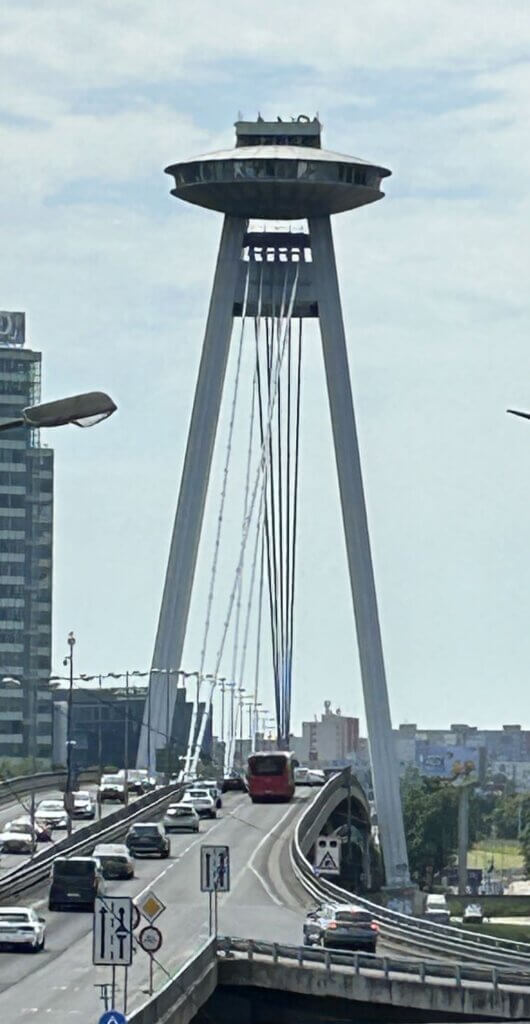
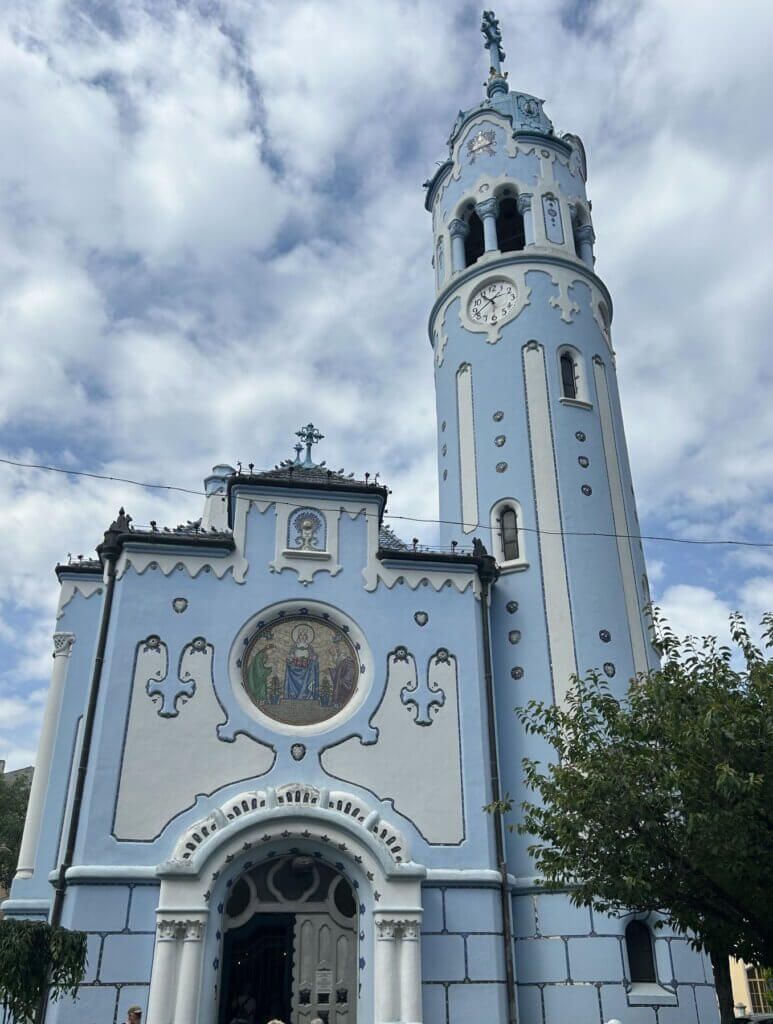
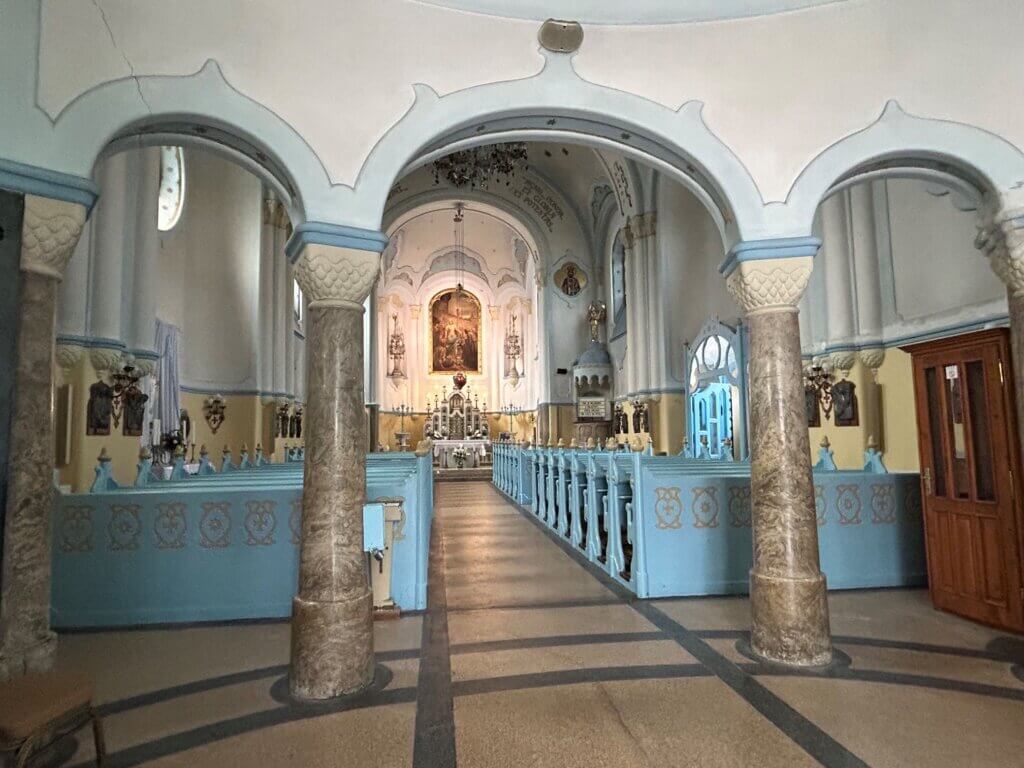
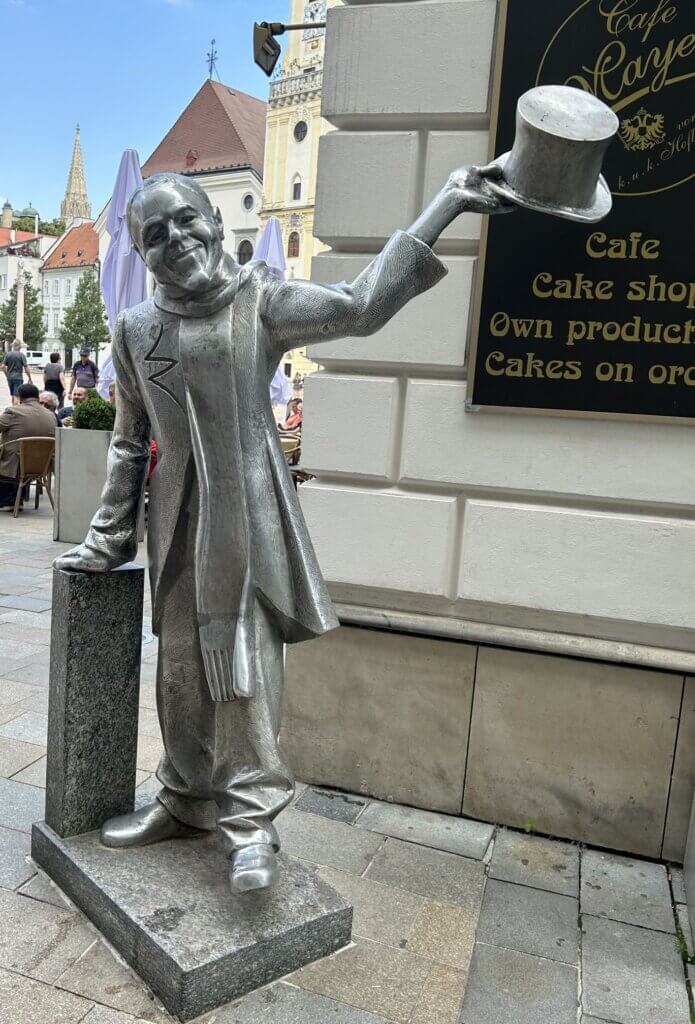
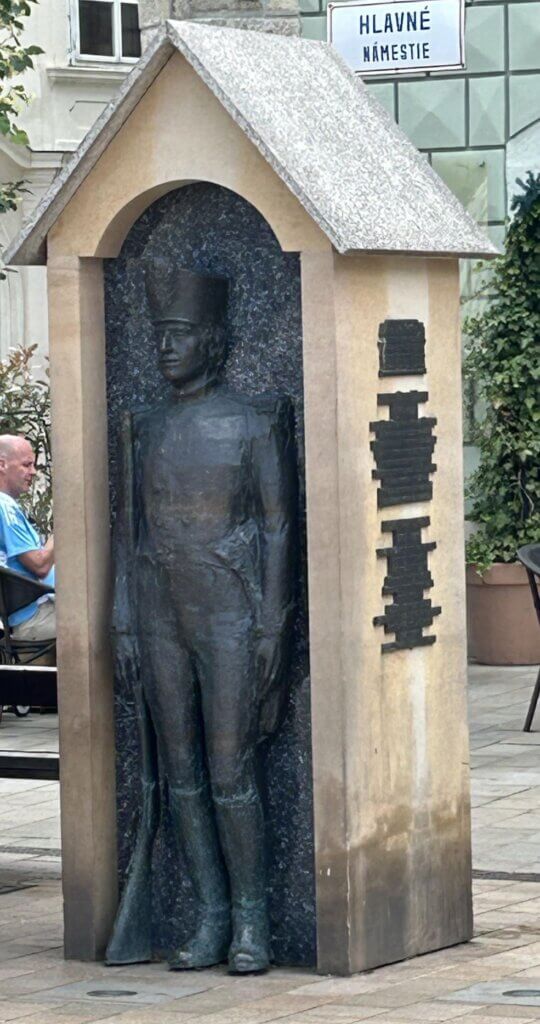
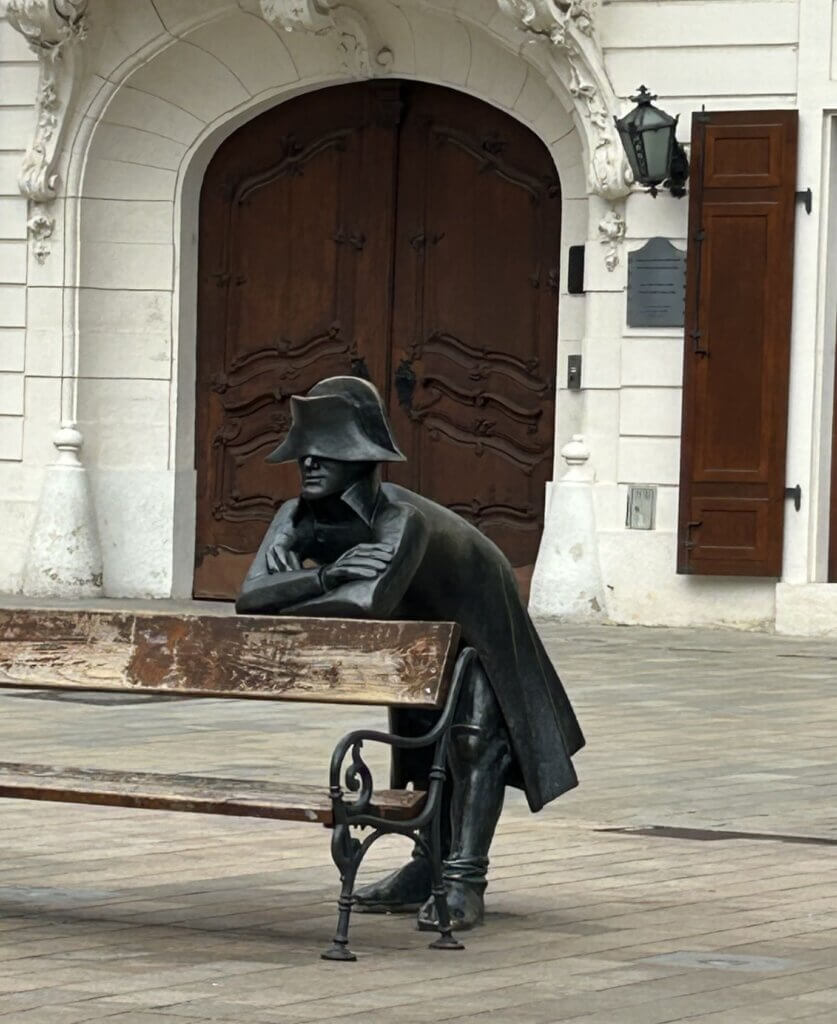
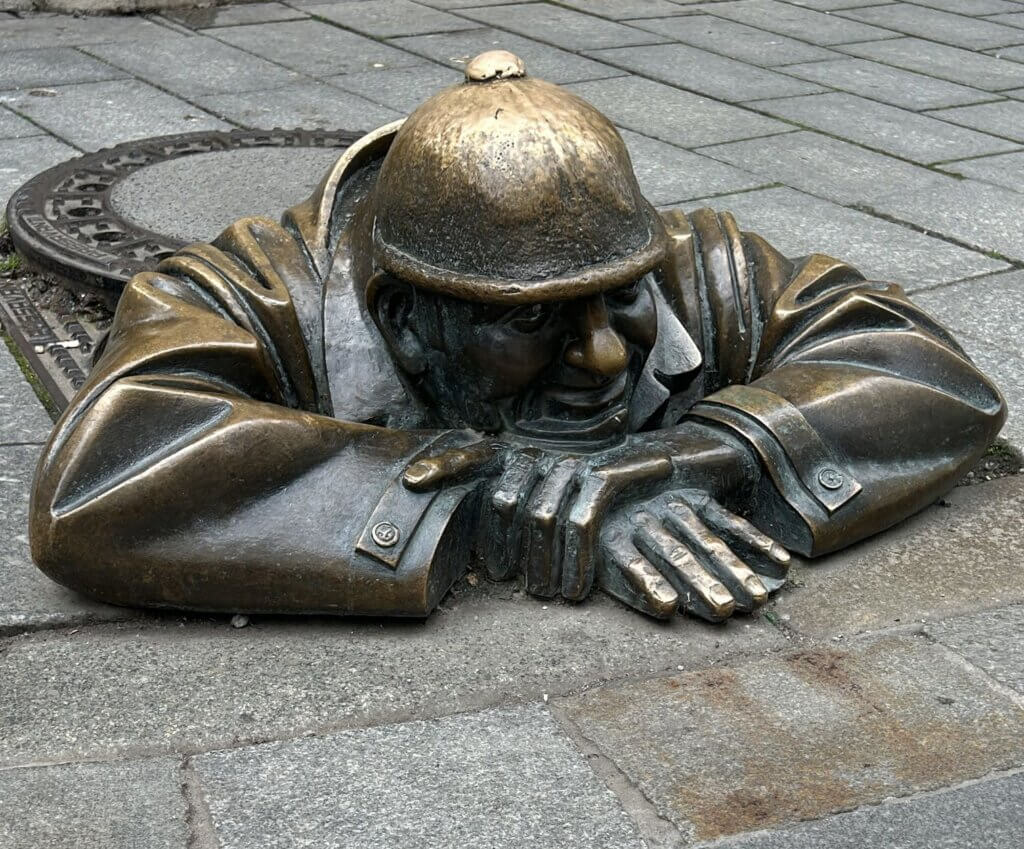
Bratislava is a city that seems to embrace cyclists. There are bike decorations everywhere, and the bike parking tower is an indication that cycling is a way of life here.
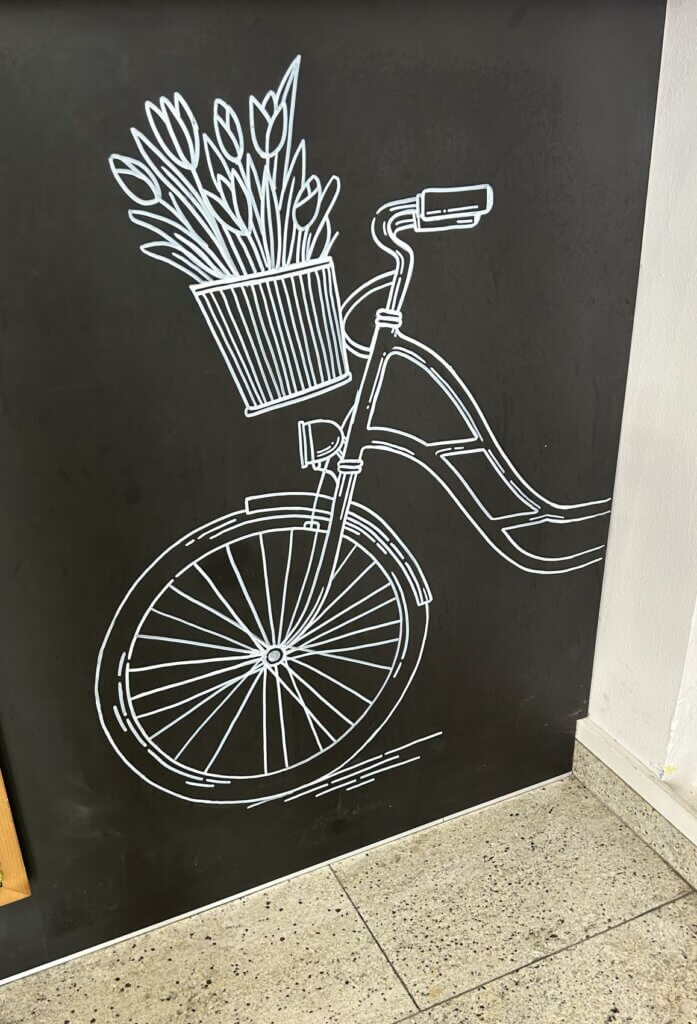
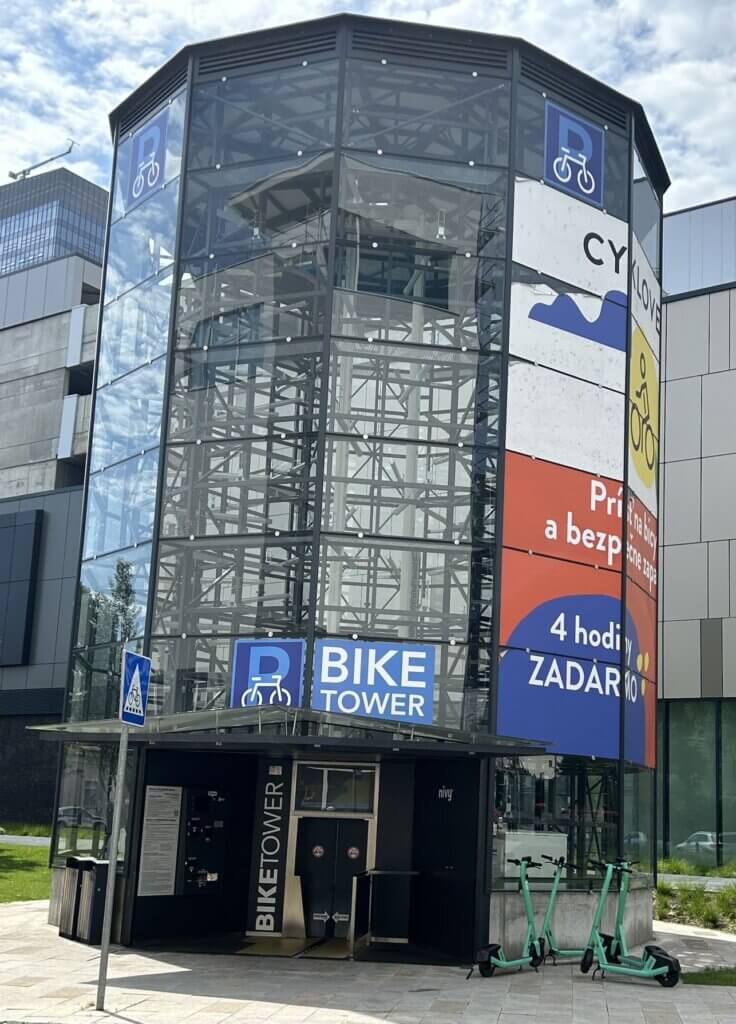
We had such a short time in Bratislava, only 1 day. We saw a lot, and we all left wanting more!
Budapest
Budapest is a magnificent city – I wish that I had known that in advance – I definitely would have planned to stay longer! The diversity of the city is amazing, combining so many eras from the Habsburg dynasty to communist rule to modern influences. The sites are impressive and all come with a unique story that tells a lot about the complex history of Budapest. There is so much to learn, so much to take in, it is overwhelming for a 2-day visit. So much to see, so little time.
We started with a 2-hour walking tour, which I always enjoy in a new city. You hear some good stories from a resident, you get an overall orientation, and you can decide where you want to go back to. Even better if it is a food walking tour!
After the tour I headed to the Róth Miksa Museum, dedicated to a stained glass artist. It was a small museum which I was grateful for – my head was in overload by then. There are over 60 museums in Budapest, you could easily spend days there exploring the city. In the evening several of the group did a Vampires & Myths Walking Tour, which was really fun. The guide dressed the part and we saw a different part of the city (Buda Castle). An added bonus – we also were treated to seeing Budapest at night.
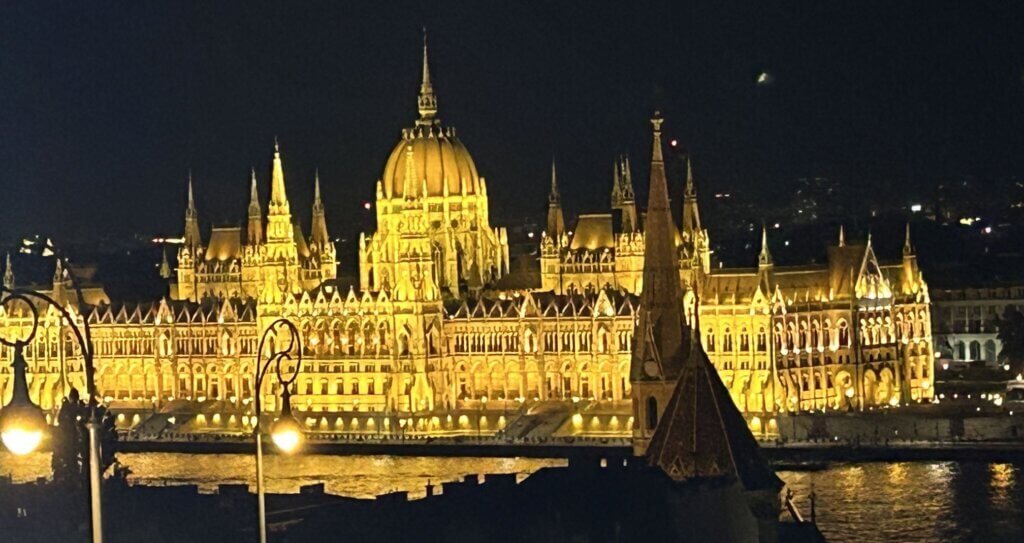
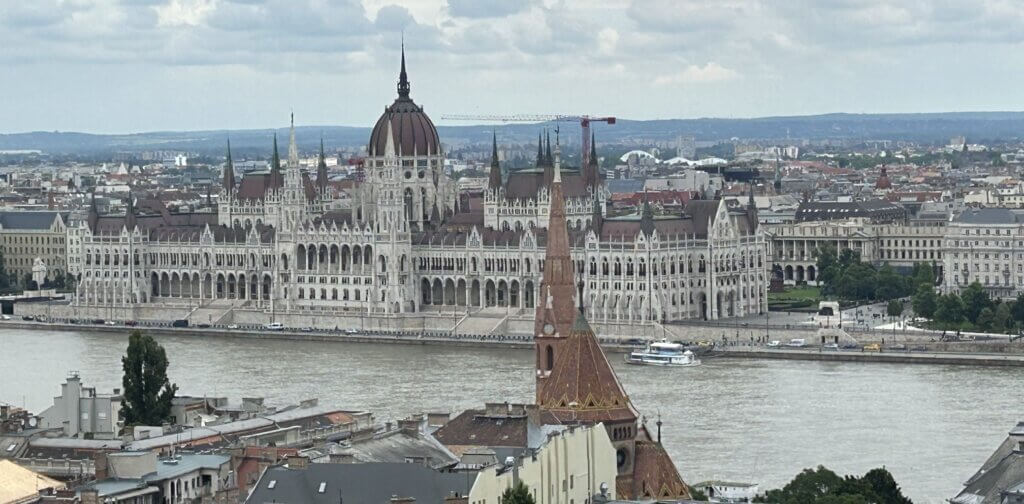
The following day I headed to the Great Market Hall to because I love local markets. I toured a couple of the more well-known landmarks, St. Stephen’s Basilica and then went to the Matthias church near Buda Castle.
St. Stephen’s is the most sacred Catholic church in Hungary, famous for the mummified right hand of the church’s patron and the first King of Hungary, King St. Stephen, dating from 1038. Throughout the centuries, the “Holy Right” has been moved and hidden numerous times to protect it from war and political unrest, so the relic’s authenticity is a subject of debate. Despite such doubt, the hand remains an important symbol of Hungary’s national and spiritual heritage.
I continued on to the Matthias Church at the Buda Castle, named in honour of a king, who was not a Saint. It was so beautiful, a subtle and graceful church which was in contrast to the other ornate palaces and churches I had seen recently. Its stained glass windows were especially breathtaking.
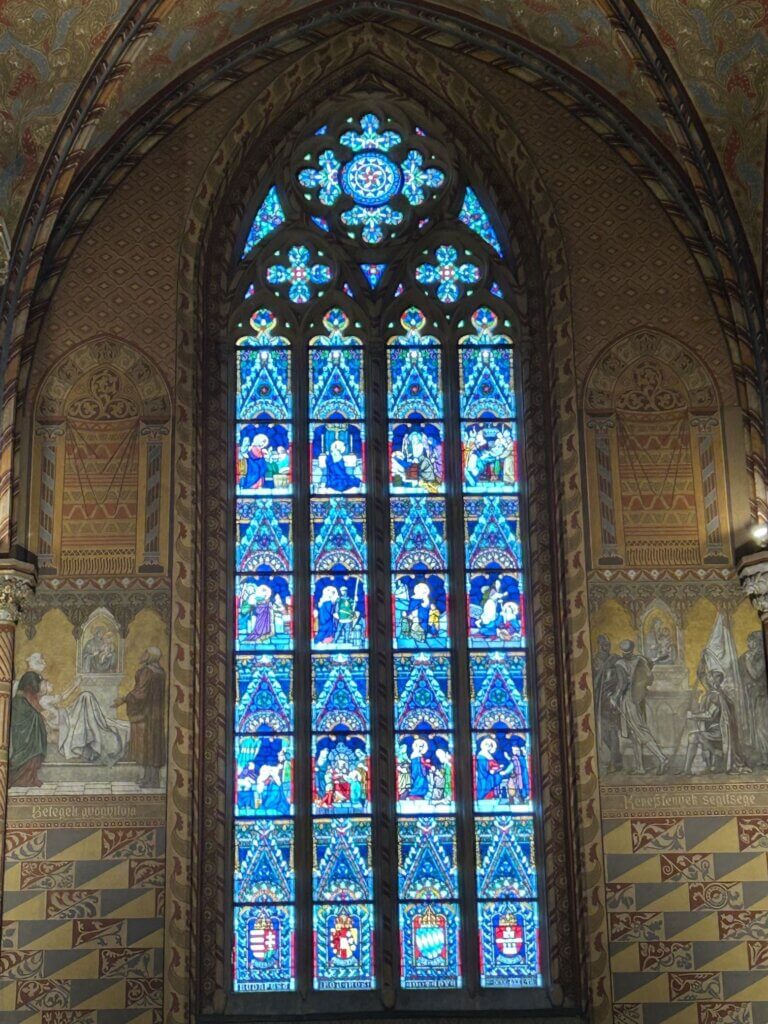
Sadly, I didn’t get to any of Budapest’s world-renowned thermal baths, which date back to around the 1st century AD, when the Romans established baths around Aquincum, the ancient settlement which is now part of Budapest.
Many of the current baths were established during the rule of the Ottoman Turks in the 16th century, displaying architectural and cultural elements from that era.
It is the combination of natural hot springs and mineral rich waters in Budapest that have contributed to the spa-culture in this city.
Iconic bath complexes include the Széchenyi Thermal Bath which is the largest and most famous; the Gellért Thermal Bath renowned for its stunning Art Nouveau architecture; the Rudas Thermal Bath famous for its night bathing sessions, and the Király Thermal Bath, which lacks its own water source, and was connected to nearby springs via an underground aqueduct, showcasing innovative engineering of the time.
Budapest’s baths are more than just places to relax; they are integral to the city’s culture, history, and daily life. They offer a unique blend of wellness, social interaction, and historical significance, making them an essential part of any visit to Budapest. They will have to wait for my next visit to this amazing city!
Where else can I go?
Please contact me if you are interested in discovering wonderful places with a new travel community!
3 highlights:
- Vienna – nighttime concert at St. Anne’s Church
- Bratislava – the many quirky statues that dot the city
- Budapest – the incredible diversity of its buildings and infrastructure
3 things for the next time:
- Vienna – attend more concerts in different venues
- Bratislava – spend more time exploring the famous landmarks such as the Bratislava Castle – we only had time for teasers
- Budapest – visit some of the iconic bath complexes in the city, and get to some of the museums
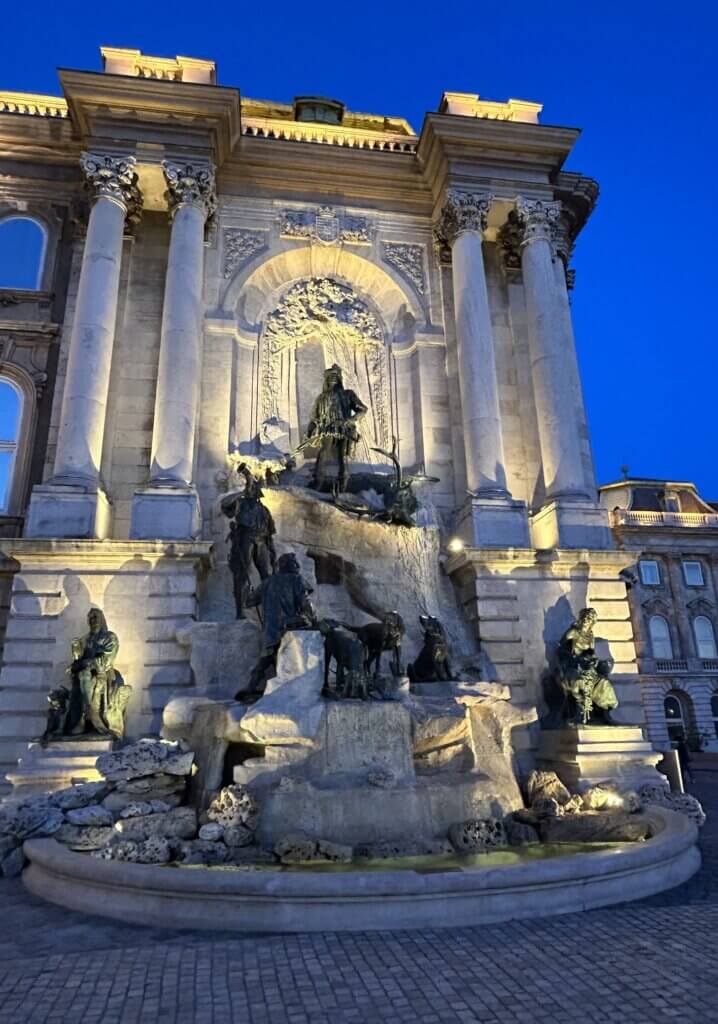
Recent Posts
Cycling Thailand
Cycling in Vietnam
Cycling in Holland
All Categories
Tags
Touring Vienna, Bratislava and Budapest
I had the good fortune to be out on a 3-country cycling adventure from Austria to Hungary in May 2024. This trip included 2 days in Slovakia, enabling a wonderful visit to the cities of Vienna, Bratislava, and Budapest.
Vienna
Vienna, the world’s most liveable city for 2024, 23 ad 22 according to the Global Liveability Index. We had about 2 and a half days in Vienna, and of course it wasn’t enough.
We arrived fairly early in the morning, and decided to navigate the local transit system to get to our hotel. It took a while, but we figured it out.
The first excursion for me was to the Albertina Museum, the largest museum for modern art in Central Europe including works from impressionist painters such as Monet and Picasso. My personal favourite kind of art.
The next day many of us visited Schönbrunn Palace, a UNESCO World Heritage Site and one of Austria’s most important cultural assets. Built in 1642, It was once the summer residence of Maria Theresa of the Habsburg dynasty, which ruled Austria for six centuries. It was a massive building with extensive gardens, a large pond with an incredible fountain, as well as a separate dining/viewing building up on the hill.

Vienna is a world destination for music so many of us wanted to experience some local music offerings. There are church venues, community venues, and of course the famous Vienna Opera House. So many options, and having only a couple of nights helped with the selection. Some of the group spent a very pleasant evening attending a concert at St. Anne’s Church, which felt very traditional. The next night the Vienna Mozart Orchestra was performing (in period costume) at the Musikverein Golden Hall. This was a fun and interactive concert, with both tourists and locals in the audience.


The other wonderful place that we had time for was the Belvedere Museum, home of the world’s largest collection of paintings by Gustav Klimt, Austria’s most famous artist. This amazing collection is housed in yet another large Habsburg palace that became one of the first public museums in the world in 1777.

There were so many areas of the city that I didn’t get to, so many museums, so many concert opportunities. All those things wait for a return visit. What we definitely made time for was for Sachertorte, the iconic cake of Vienna.
Bratislava
Our cycling took us to Bratislava, the capital of Slovakia. Bratislava is a delightful city, blending charming old town vibes (replete with cobblestone streets and medieval buildings) with uber modern structures such as the UFO bridge which spans the Danube River. When completed in 1972, this bridge was considered a significant engineering achievement.
There are so many interesting things to see in Bratislava, including the many public statues, the stunning Art Nouveau-style blue Church of St. Elizabeth, the Bratislava Castle, and St. Martin’s Cathedral, where Hungarian kings and queens were crowned for almost 300 years.







Bratislava is a city that seems to embrace cyclists. There are bike decorations everywhere, and the bike parking tower is an indication that cycling is a way of life here.


We had such a short time in Bratislava, only 1 day. We saw a lot, and we all left wanting more!
Budapest
Budapest is a magnificent city – I wish that I had known that in advance – I definitely would have planned to stay longer! The diversity of the city is amazing, combining so many eras from the Habsburg dynasty to communist rule to modern influences. The sites are impressive and all come with a unique story that tells a lot about the complex history of Budapest. There is so much to learn, so much to take in, it is overwhelming for a 2-day visit. So much to see, so little time.
We started with a 2-hour walking tour, which I always enjoy in a new city. You hear some good stories from a resident, you get an overall orientation, and you can decide where you want to go back to. Even better if it is a food walking tour!
After the tour I headed to the Róth Miksa Museum, dedicated to a stained glass artist. It was a small museum which I was grateful for – my head was in overload by then. There are over 60 museums in Budapest, you could easily spend days there exploring the city. In the evening several of the group did a Vampires & Myths Walking Tour, which was really fun. The guide dressed the part and we saw a different part of the city (Buda Castle). An added bonus – we also were treated to seeing Budapest at night.


The following day I headed to the Great Market Hall to because I love local markets. I toured a couple of the more well-known landmarks, St. Stephen’s Basilica and then went to the Matthias church near Buda Castle.
St. Stephen’s is the most sacred Catholic church in Hungary, famous for the mummified right hand of the church’s patron and the first King of Hungary, King St. Stephen, dating from 1038. Throughout the centuries, the “Holy Right” has been moved and hidden numerous times to protect it from war and political unrest, so the relic’s authenticity is a subject of debate. Despite such doubt, the hand remains an important symbol of Hungary’s national and spiritual heritage.
I continued on to the Matthias Church at the Buda Castle, named in honour of a king, who was not a Saint. It was so beautiful, a subtle and graceful church which was in contrast to the other ornate palaces and churches I had seen recently. Its stained glass windows were especially breathtaking.

Sadly, I didn’t get to any of Budapest’s world-renowned thermal baths, which date back to around the 1st century AD, when the Romans established baths around Aquincum, the ancient settlement which is now part of Budapest.
Many of the current baths were established during the rule of the Ottoman Turks in the 16th century, displaying architectural and cultural elements from that era.
It is the combination of natural hot springs and mineral rich waters in Budapest that have contributed to the spa-culture in this city.
Iconic bath complexes include the Széchenyi Thermal Bath which is the largest and most famous; the Gellért Thermal Bath renowned for its stunning Art Nouveau architecture; the Rudas Thermal Bath famous for its night bathing sessions, and the Király Thermal Bath, which lacks its own water source, and was connected to nearby springs via an underground aqueduct, showcasing innovative engineering of the time.
Budapest’s baths are more than just places to relax; they are integral to the city’s culture, history, and daily life. They offer a unique blend of wellness, social interaction, and historical significance, making them an essential part of any visit to Budapest. They will have to wait for my next visit to this amazing city!
Where else can I go?
Please contact me if you are interested in discovering wonderful places with a new travel community!
3 highlights:
- Vienna – nighttime concert at St. Anne’s Church
- Bratislava – the many quirky statues that dot the city
- Budapest – the incredible diversity of its buildings and infrastructure
3 things for the next time:
- Vienna – attend more concerts in different venues
- Bratislava – spend more time exploring the famous landmarks such as the Bratislava Castle – we only had time for teasers
- Budapest – visit some of the iconic bath complexes in the city, and get to some of the museums

